Marketing Plan Report: Clean Force Property Services, Melbourne
VerifiedAdded on 2020/04/07
|17
|3789
|43
Report
AI Summary
This report provides a comprehensive analysis of the marketing plan for Clean Force Property Services, a commercial cleaning service operating in metropolitan Melbourne. The report begins with an executive summary outlining the key aspects of the plan and the company's objectives. It then delves into a situation analysis, examining the company's current market position and the competitive landscape. The core of the report explores various marketing tools and frameworks, including product lifecycle analysis, the BCG matrix, and Ansoff analysis, to assess the company's growth strategies. The report examines market penetration, market development, product development, and diversification strategies. It outlines the company's principal marketing objectives and brand positioning strategy, alongside an analysis of the marketing mix. The report concludes with a framework of marketing metrics and ROI analysis. The report highlights the importance of effective pricing strategies, market share growth, and customer acquisition in achieving the company's goals. The report is designed to provide a roadmap for the company's marketing efforts, emphasizing the importance of aligning marketing strategies with broader company objectives.
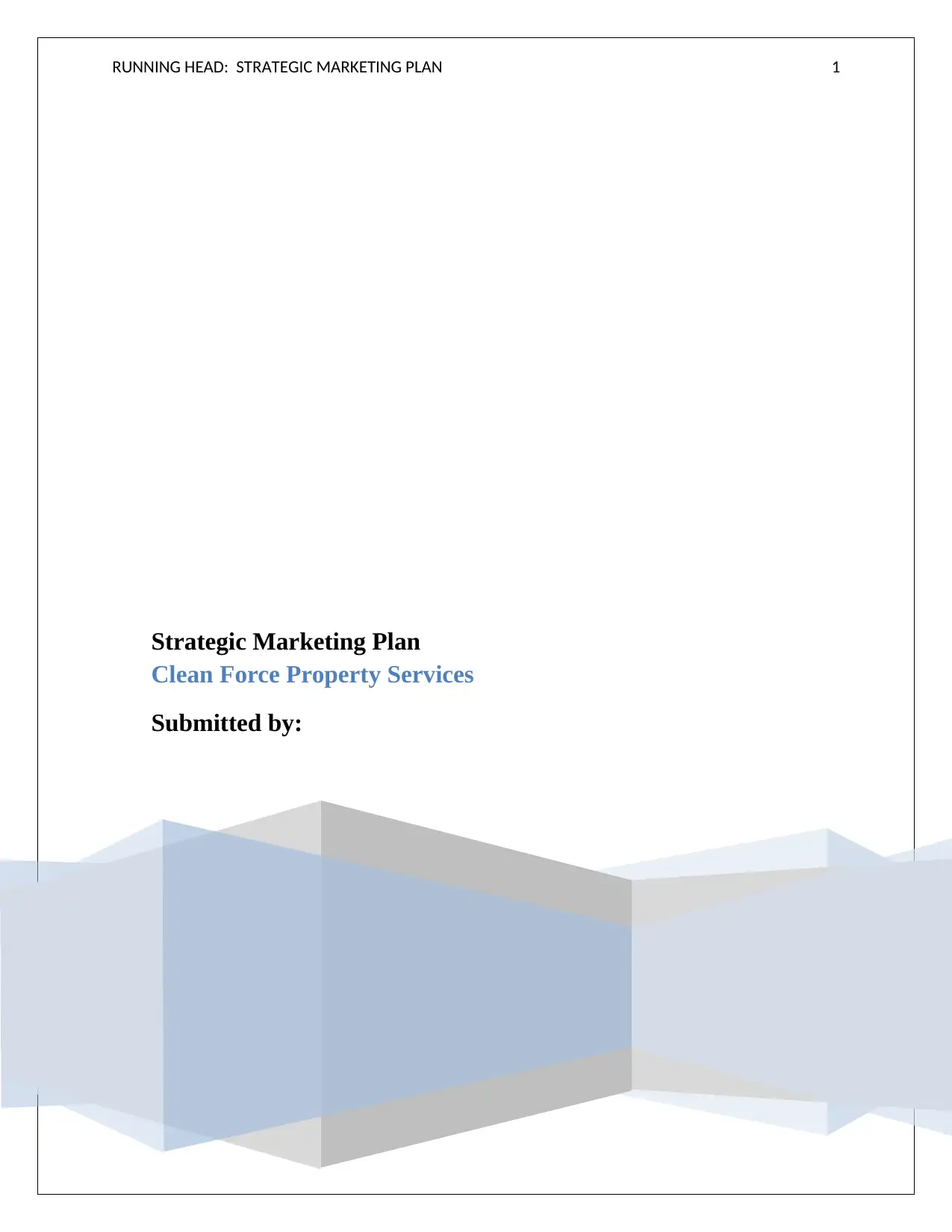
RUNNING HEAD: STRATEGIC MARKETING PLAN 1
Strategic Marketing Plan
Clean Force Property Services
Submitted by:
Strategic Marketing Plan
Clean Force Property Services
Submitted by:
Paraphrase This Document
Need a fresh take? Get an instant paraphrase of this document with our AI Paraphraser
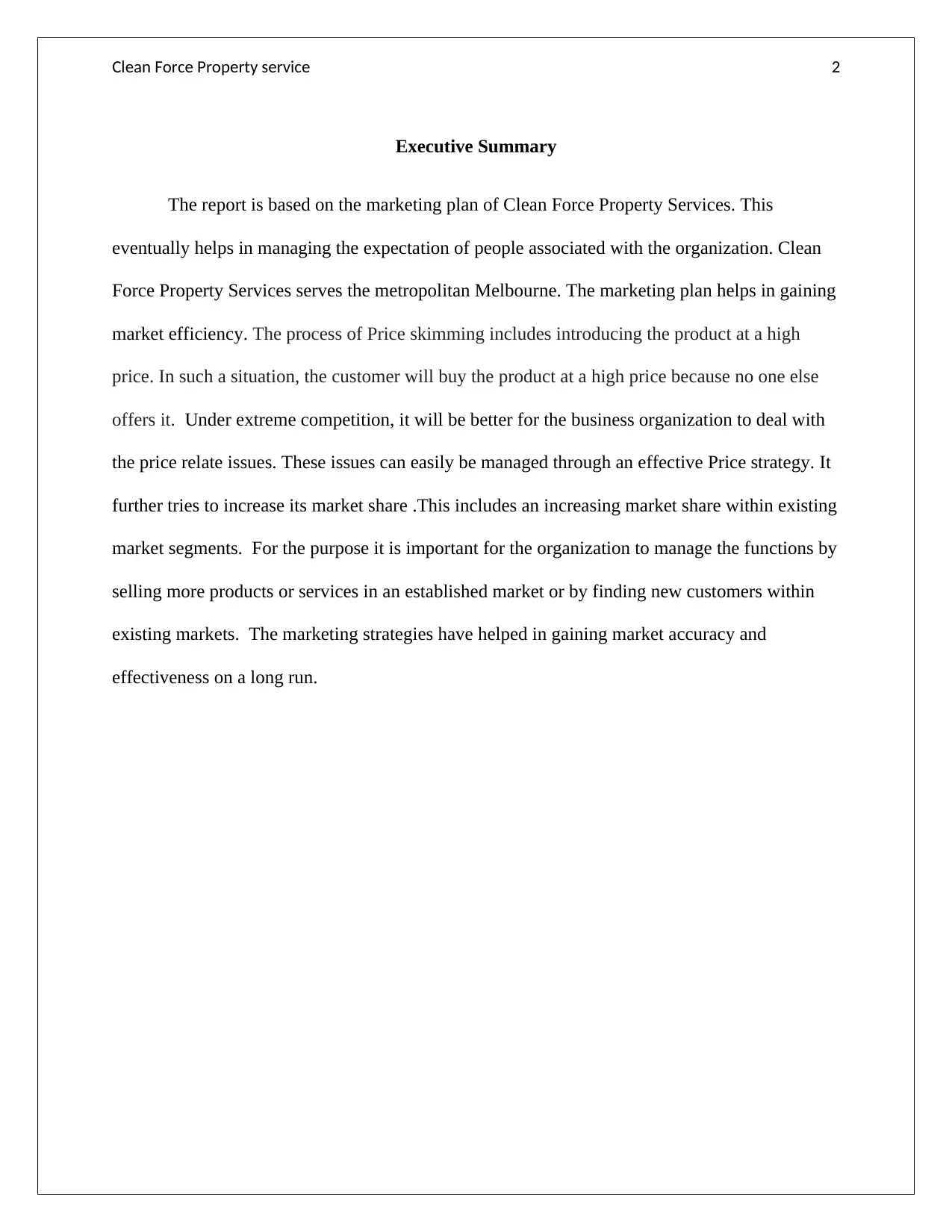
Clean Force Property service 2
Executive Summary
The report is based on the marketing plan of Clean Force Property Services. This
eventually helps in managing the expectation of people associated with the organization. Clean
Force Property Services serves the metropolitan Melbourne. The marketing plan helps in gaining
market efficiency. The process of Price skimming includes introducing the product at a high
price. In such a situation, the customer will buy the product at a high price because no one else
offers it. Under extreme competition, it will be better for the business organization to deal with
the price relate issues. These issues can easily be managed through an effective Price strategy. It
further tries to increase its market share .This includes an increasing market share within existing
market segments. For the purpose it is important for the organization to manage the functions by
selling more products or services in an established market or by finding new customers within
existing markets. The marketing strategies have helped in gaining market accuracy and
effectiveness on a long run.
Executive Summary
The report is based on the marketing plan of Clean Force Property Services. This
eventually helps in managing the expectation of people associated with the organization. Clean
Force Property Services serves the metropolitan Melbourne. The marketing plan helps in gaining
market efficiency. The process of Price skimming includes introducing the product at a high
price. In such a situation, the customer will buy the product at a high price because no one else
offers it. Under extreme competition, it will be better for the business organization to deal with
the price relate issues. These issues can easily be managed through an effective Price strategy. It
further tries to increase its market share .This includes an increasing market share within existing
market segments. For the purpose it is important for the organization to manage the functions by
selling more products or services in an established market or by finding new customers within
existing markets. The marketing strategies have helped in gaining market accuracy and
effectiveness on a long run.
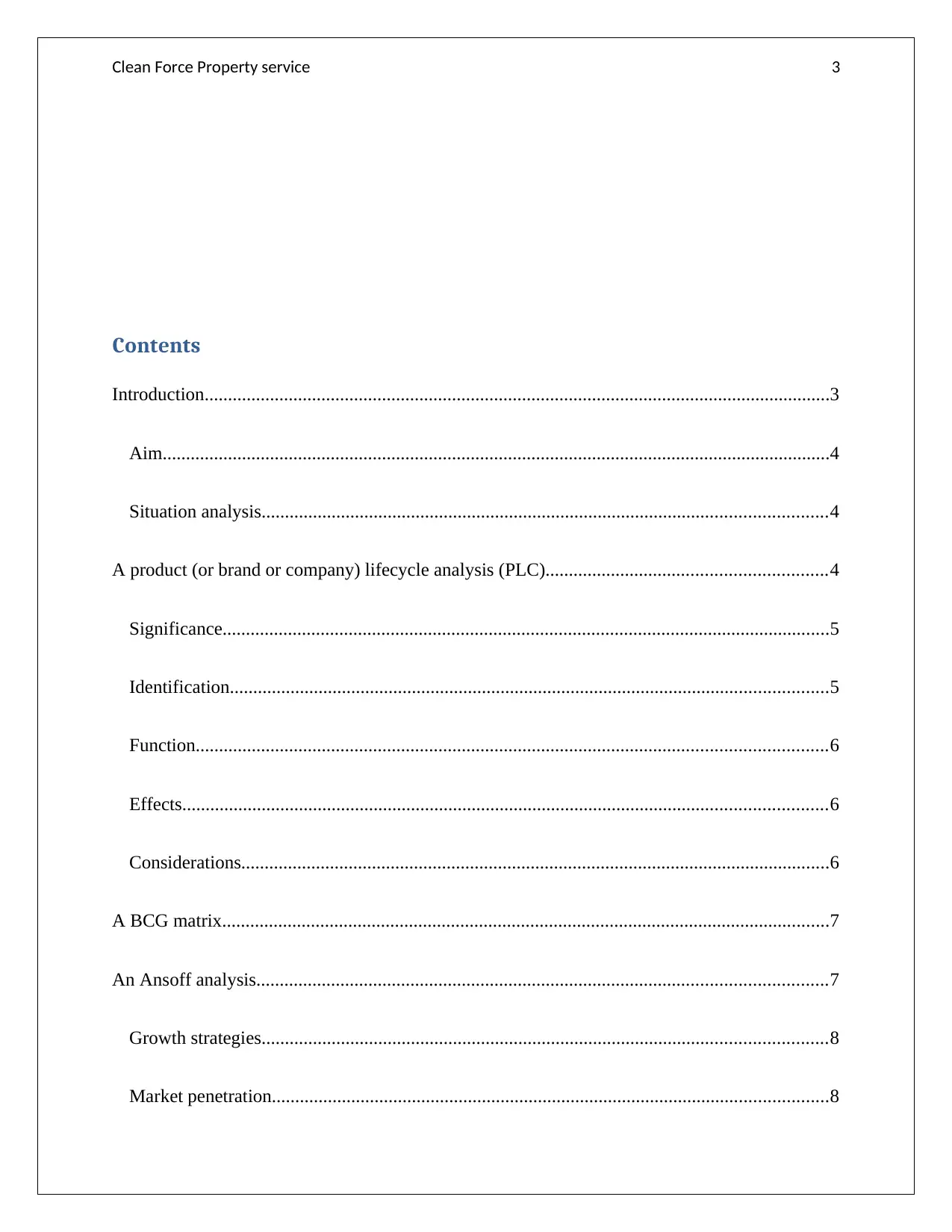
Clean Force Property service 3
Contents
Introduction......................................................................................................................................3
Aim...............................................................................................................................................4
Situation analysis.........................................................................................................................4
A product (or brand or company) lifecycle analysis (PLC)............................................................4
Significance..................................................................................................................................5
Identification................................................................................................................................5
Function.......................................................................................................................................6
Effects..........................................................................................................................................6
Considerations..............................................................................................................................6
A BCG matrix..................................................................................................................................7
An Ansoff analysis..........................................................................................................................7
Growth strategies.........................................................................................................................8
Market penetration.......................................................................................................................8
Contents
Introduction......................................................................................................................................3
Aim...............................................................................................................................................4
Situation analysis.........................................................................................................................4
A product (or brand or company) lifecycle analysis (PLC)............................................................4
Significance..................................................................................................................................5
Identification................................................................................................................................5
Function.......................................................................................................................................6
Effects..........................................................................................................................................6
Considerations..............................................................................................................................6
A BCG matrix..................................................................................................................................7
An Ansoff analysis..........................................................................................................................7
Growth strategies.........................................................................................................................8
Market penetration.......................................................................................................................8
⊘ This is a preview!⊘
Do you want full access?
Subscribe today to unlock all pages.

Trusted by 1+ million students worldwide
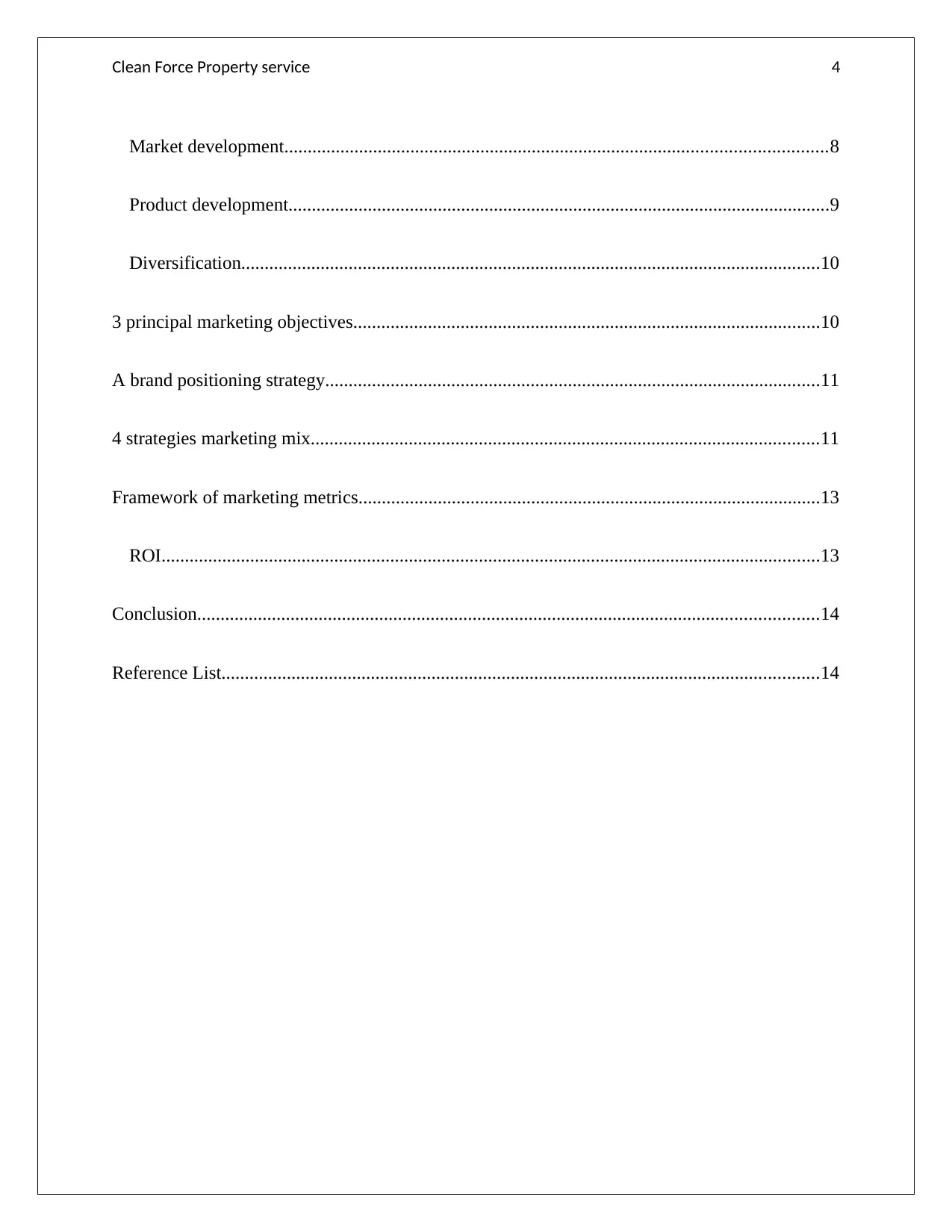
Clean Force Property service 4
Market development....................................................................................................................8
Product development....................................................................................................................9
Diversification............................................................................................................................10
3 principal marketing objectives....................................................................................................10
A brand positioning strategy..........................................................................................................11
4 strategies marketing mix.............................................................................................................11
Framework of marketing metrics...................................................................................................13
ROI.............................................................................................................................................13
Conclusion.....................................................................................................................................14
Reference List................................................................................................................................14
Market development....................................................................................................................8
Product development....................................................................................................................9
Diversification............................................................................................................................10
3 principal marketing objectives....................................................................................................10
A brand positioning strategy..........................................................................................................11
4 strategies marketing mix.............................................................................................................11
Framework of marketing metrics...................................................................................................13
ROI.............................................................................................................................................13
Conclusion.....................................................................................................................................14
Reference List................................................................................................................................14
Paraphrase This Document
Need a fresh take? Get an instant paraphrase of this document with our AI Paraphraser
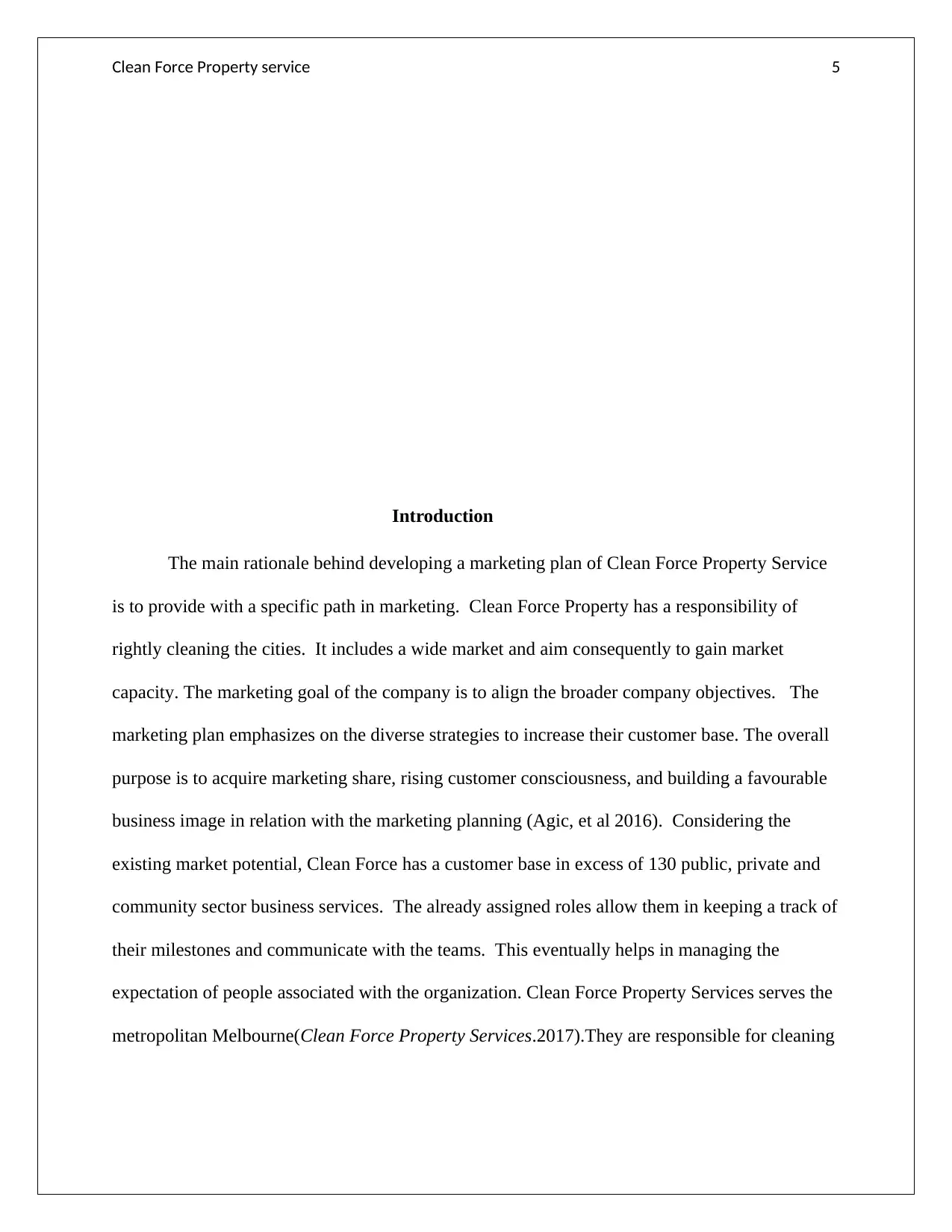
Clean Force Property service 5
Introduction
The main rationale behind developing a marketing plan of Clean Force Property Service
is to provide with a specific path in marketing. Clean Force Property has a responsibility of
rightly cleaning the cities. It includes a wide market and aim consequently to gain market
capacity. The marketing goal of the company is to align the broader company objectives. The
marketing plan emphasizes on the diverse strategies to increase their customer base. The overall
purpose is to acquire marketing share, rising customer consciousness, and building a favourable
business image in relation with the marketing planning (Agic, et al 2016). Considering the
existing market potential, Clean Force has a customer base in excess of 130 public, private and
community sector business services. The already assigned roles allow them in keeping a track of
their milestones and communicate with the teams. This eventually helps in managing the
expectation of people associated with the organization. Clean Force Property Services serves the
metropolitan Melbourne(Clean Force Property Services.2017).They are responsible for cleaning
Introduction
The main rationale behind developing a marketing plan of Clean Force Property Service
is to provide with a specific path in marketing. Clean Force Property has a responsibility of
rightly cleaning the cities. It includes a wide market and aim consequently to gain market
capacity. The marketing goal of the company is to align the broader company objectives. The
marketing plan emphasizes on the diverse strategies to increase their customer base. The overall
purpose is to acquire marketing share, rising customer consciousness, and building a favourable
business image in relation with the marketing planning (Agic, et al 2016). Considering the
existing market potential, Clean Force has a customer base in excess of 130 public, private and
community sector business services. The already assigned roles allow them in keeping a track of
their milestones and communicate with the teams. This eventually helps in managing the
expectation of people associated with the organization. Clean Force Property Services serves the
metropolitan Melbourne(Clean Force Property Services.2017).They are responsible for cleaning
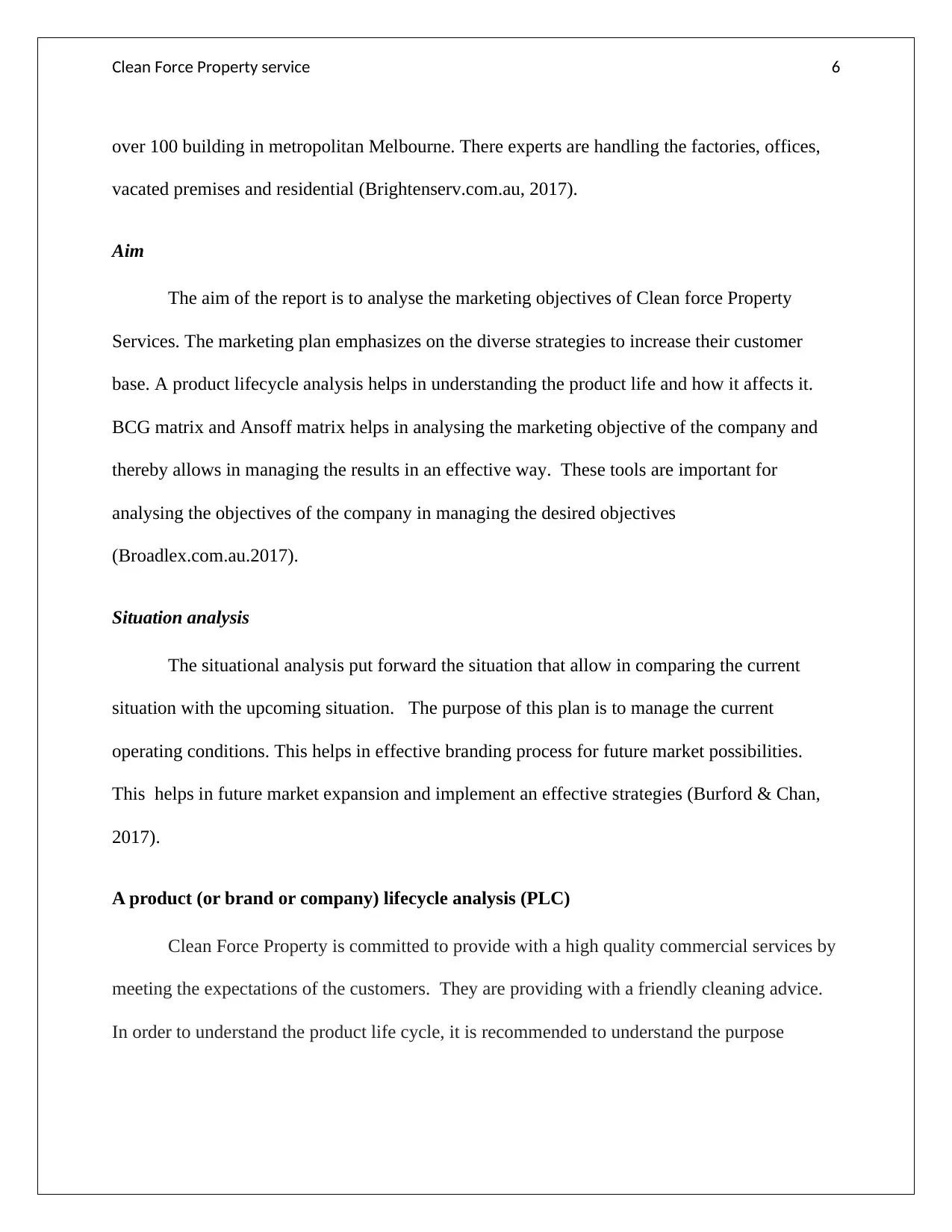
Clean Force Property service 6
over 100 building in metropolitan Melbourne. There experts are handling the factories, offices,
vacated premises and residential (Brightenserv.com.au, 2017).
Aim
The aim of the report is to analyse the marketing objectives of Clean force Property
Services. The marketing plan emphasizes on the diverse strategies to increase their customer
base. A product lifecycle analysis helps in understanding the product life and how it affects it.
BCG matrix and Ansoff matrix helps in analysing the marketing objective of the company and
thereby allows in managing the results in an effective way. These tools are important for
analysing the objectives of the company in managing the desired objectives
(Broadlex.com.au.2017).
Situation analysis
The situational analysis put forward the situation that allow in comparing the current
situation with the upcoming situation. The purpose of this plan is to manage the current
operating conditions. This helps in effective branding process for future market possibilities.
This helps in future market expansion and implement an effective strategies (Burford & Chan,
2017).
A product (or brand or company) lifecycle analysis (PLC)
Clean Force Property is committed to provide with a high quality commercial services by
meeting the expectations of the customers. They are providing with a friendly cleaning advice.
In order to understand the product life cycle, it is recommended to understand the purpose
over 100 building in metropolitan Melbourne. There experts are handling the factories, offices,
vacated premises and residential (Brightenserv.com.au, 2017).
Aim
The aim of the report is to analyse the marketing objectives of Clean force Property
Services. The marketing plan emphasizes on the diverse strategies to increase their customer
base. A product lifecycle analysis helps in understanding the product life and how it affects it.
BCG matrix and Ansoff matrix helps in analysing the marketing objective of the company and
thereby allows in managing the results in an effective way. These tools are important for
analysing the objectives of the company in managing the desired objectives
(Broadlex.com.au.2017).
Situation analysis
The situational analysis put forward the situation that allow in comparing the current
situation with the upcoming situation. The purpose of this plan is to manage the current
operating conditions. This helps in effective branding process for future market possibilities.
This helps in future market expansion and implement an effective strategies (Burford & Chan,
2017).
A product (or brand or company) lifecycle analysis (PLC)
Clean Force Property is committed to provide with a high quality commercial services by
meeting the expectations of the customers. They are providing with a friendly cleaning advice.
In order to understand the product life cycle, it is recommended to understand the purpose
⊘ This is a preview!⊘
Do you want full access?
Subscribe today to unlock all pages.

Trusted by 1+ million students worldwide
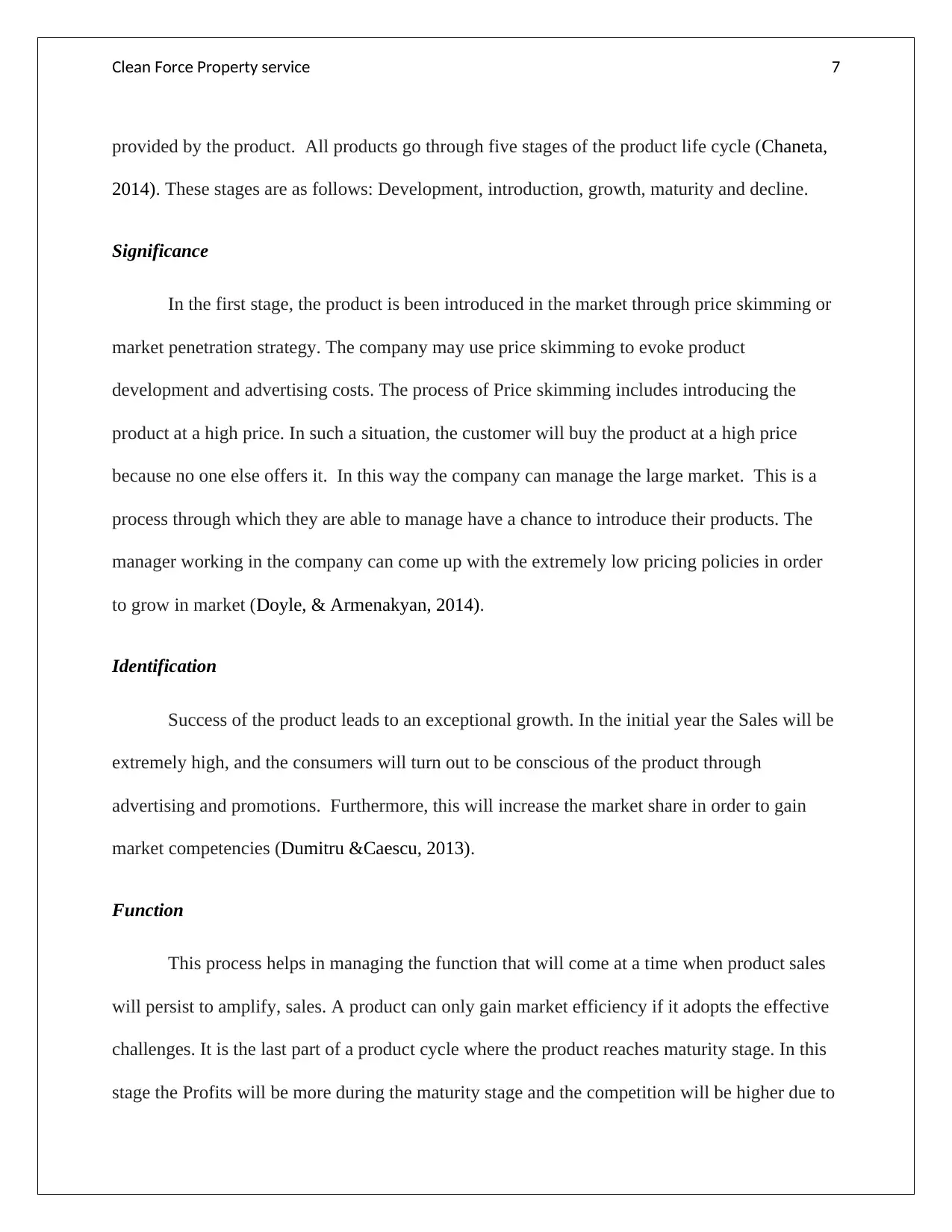
Clean Force Property service 7
provided by the product. All products go through five stages of the product life cycle (Chaneta,
2014). These stages are as follows: Development, introduction, growth, maturity and decline.
Significance
In the first stage, the product is been introduced in the market through price skimming or
market penetration strategy. The company may use price skimming to evoke product
development and advertising costs. The process of Price skimming includes introducing the
product at a high price. In such a situation, the customer will buy the product at a high price
because no one else offers it. In this way the company can manage the large market. This is a
process through which they are able to manage have a chance to introduce their products. The
manager working in the company can come up with the extremely low pricing policies in order
to grow in market (Doyle, & Armenakyan, 2014).
Identification
Success of the product leads to an exceptional growth. In the initial year the Sales will be
extremely high, and the consumers will turn out to be conscious of the product through
advertising and promotions. Furthermore, this will increase the market share in order to gain
market competencies (Dumitru &Caescu, 2013).
Function
This process helps in managing the function that will come at a time when product sales
will persist to amplify, sales. A product can only gain market efficiency if it adopts the effective
challenges. It is the last part of a product cycle where the product reaches maturity stage. In this
stage the Profits will be more during the maturity stage and the competition will be higher due to
provided by the product. All products go through five stages of the product life cycle (Chaneta,
2014). These stages are as follows: Development, introduction, growth, maturity and decline.
Significance
In the first stage, the product is been introduced in the market through price skimming or
market penetration strategy. The company may use price skimming to evoke product
development and advertising costs. The process of Price skimming includes introducing the
product at a high price. In such a situation, the customer will buy the product at a high price
because no one else offers it. In this way the company can manage the large market. This is a
process through which they are able to manage have a chance to introduce their products. The
manager working in the company can come up with the extremely low pricing policies in order
to grow in market (Doyle, & Armenakyan, 2014).
Identification
Success of the product leads to an exceptional growth. In the initial year the Sales will be
extremely high, and the consumers will turn out to be conscious of the product through
advertising and promotions. Furthermore, this will increase the market share in order to gain
market competencies (Dumitru &Caescu, 2013).
Function
This process helps in managing the function that will come at a time when product sales
will persist to amplify, sales. A product can only gain market efficiency if it adopts the effective
challenges. It is the last part of a product cycle where the product reaches maturity stage. In this
stage the Profits will be more during the maturity stage and the competition will be higher due to
Paraphrase This Document
Need a fresh take? Get an instant paraphrase of this document with our AI Paraphraser
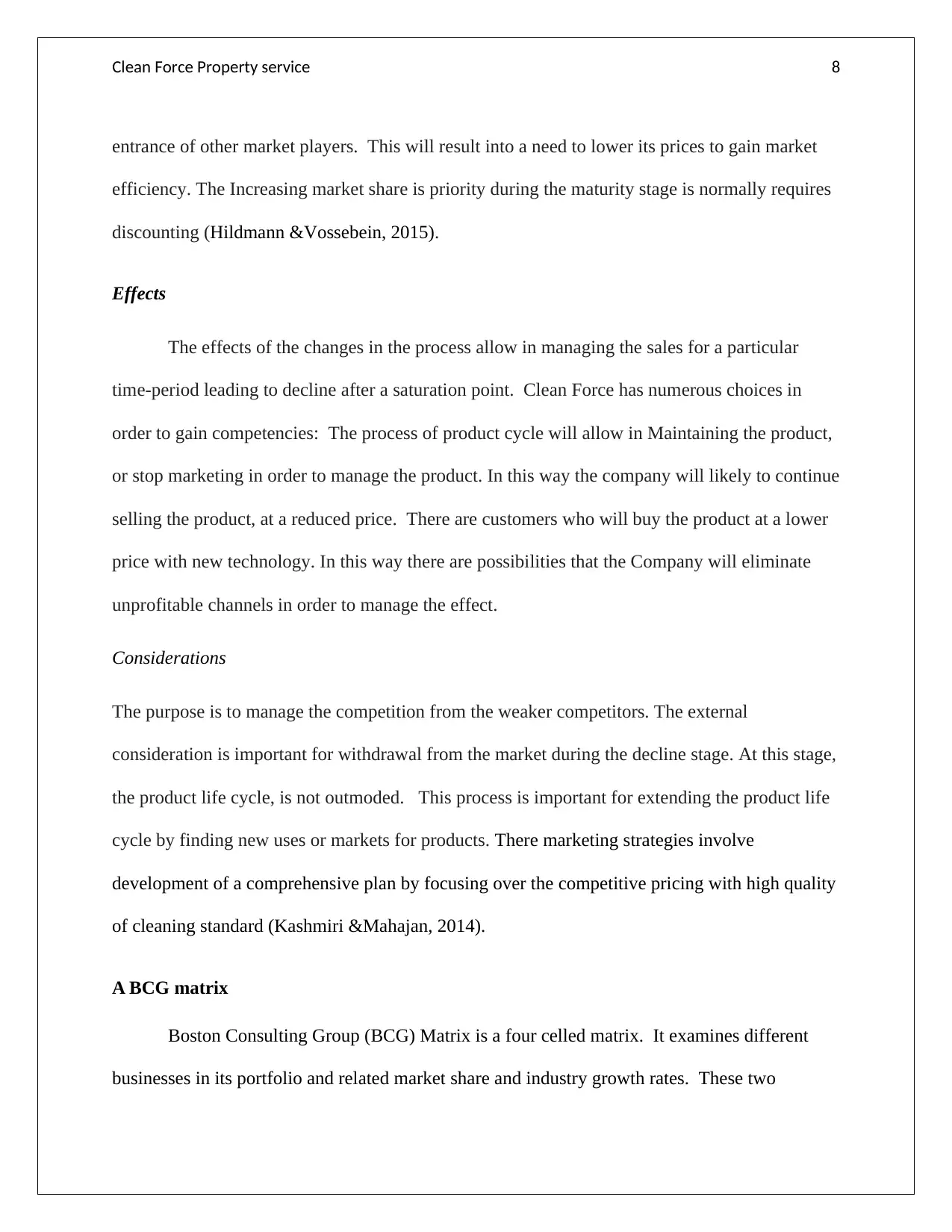
Clean Force Property service 8
entrance of other market players. This will result into a need to lower its prices to gain market
efficiency. The Increasing market share is priority during the maturity stage is normally requires
discounting (Hildmann &Vossebein, 2015).
Effects
The effects of the changes in the process allow in managing the sales for a particular
time-period leading to decline after a saturation point. Clean Force has numerous choices in
order to gain competencies: The process of product cycle will allow in Maintaining the product,
or stop marketing in order to manage the product. In this way the company will likely to continue
selling the product, at a reduced price. There are customers who will buy the product at a lower
price with new technology. In this way there are possibilities that the Company will eliminate
unprofitable channels in order to manage the effect.
Considerations
The purpose is to manage the competition from the weaker competitors. The external
consideration is important for withdrawal from the market during the decline stage. At this stage,
the product life cycle, is not outmoded. This process is important for extending the product life
cycle by finding new uses or markets for products. There marketing strategies involve
development of a comprehensive plan by focusing over the competitive pricing with high quality
of cleaning standard (Kashmiri &Mahajan, 2014).
A BCG matrix
Boston Consulting Group (BCG) Matrix is a four celled matrix. It examines different
businesses in its portfolio and related market share and industry growth rates. These two
entrance of other market players. This will result into a need to lower its prices to gain market
efficiency. The Increasing market share is priority during the maturity stage is normally requires
discounting (Hildmann &Vossebein, 2015).
Effects
The effects of the changes in the process allow in managing the sales for a particular
time-period leading to decline after a saturation point. Clean Force has numerous choices in
order to gain competencies: The process of product cycle will allow in Maintaining the product,
or stop marketing in order to manage the product. In this way the company will likely to continue
selling the product, at a reduced price. There are customers who will buy the product at a lower
price with new technology. In this way there are possibilities that the Company will eliminate
unprofitable channels in order to manage the effect.
Considerations
The purpose is to manage the competition from the weaker competitors. The external
consideration is important for withdrawal from the market during the decline stage. At this stage,
the product life cycle, is not outmoded. This process is important for extending the product life
cycle by finding new uses or markets for products. There marketing strategies involve
development of a comprehensive plan by focusing over the competitive pricing with high quality
of cleaning standard (Kashmiri &Mahajan, 2014).
A BCG matrix
Boston Consulting Group (BCG) Matrix is a four celled matrix. It examines different
businesses in its portfolio and related market share and industry growth rates. These two
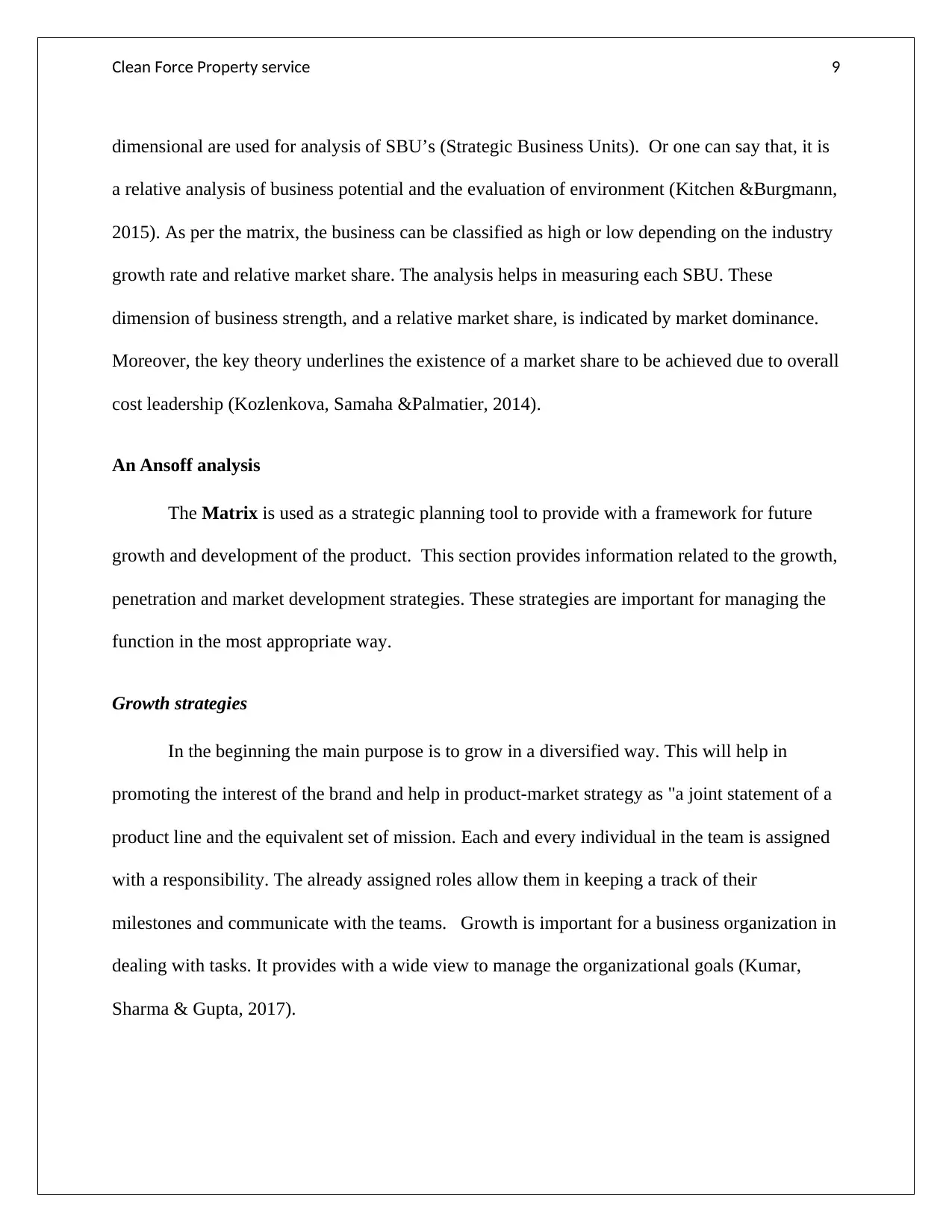
Clean Force Property service 9
dimensional are used for analysis of SBU’s (Strategic Business Units). Or one can say that, it is
a relative analysis of business potential and the evaluation of environment (Kitchen &Burgmann,
2015). As per the matrix, the business can be classified as high or low depending on the industry
growth rate and relative market share. The analysis helps in measuring each SBU. These
dimension of business strength, and a relative market share, is indicated by market dominance.
Moreover, the key theory underlines the existence of a market share to be achieved due to overall
cost leadership (Kozlenkova, Samaha &Palmatier, 2014).
An Ansoff analysis
The Matrix is used as a strategic planning tool to provide with a framework for future
growth and development of the product. This section provides information related to the growth,
penetration and market development strategies. These strategies are important for managing the
function in the most appropriate way.
Growth strategies
In the beginning the main purpose is to grow in a diversified way. This will help in
promoting the interest of the brand and help in product-market strategy as "a joint statement of a
product line and the equivalent set of mission. Each and every individual in the team is assigned
with a responsibility. The already assigned roles allow them in keeping a track of their
milestones and communicate with the teams. Growth is important for a business organization in
dealing with tasks. It provides with a wide view to manage the organizational goals (Kumar,
Sharma & Gupta, 2017).
dimensional are used for analysis of SBU’s (Strategic Business Units). Or one can say that, it is
a relative analysis of business potential and the evaluation of environment (Kitchen &Burgmann,
2015). As per the matrix, the business can be classified as high or low depending on the industry
growth rate and relative market share. The analysis helps in measuring each SBU. These
dimension of business strength, and a relative market share, is indicated by market dominance.
Moreover, the key theory underlines the existence of a market share to be achieved due to overall
cost leadership (Kozlenkova, Samaha &Palmatier, 2014).
An Ansoff analysis
The Matrix is used as a strategic planning tool to provide with a framework for future
growth and development of the product. This section provides information related to the growth,
penetration and market development strategies. These strategies are important for managing the
function in the most appropriate way.
Growth strategies
In the beginning the main purpose is to grow in a diversified way. This will help in
promoting the interest of the brand and help in product-market strategy as "a joint statement of a
product line and the equivalent set of mission. Each and every individual in the team is assigned
with a responsibility. The already assigned roles allow them in keeping a track of their
milestones and communicate with the teams. Growth is important for a business organization in
dealing with tasks. It provides with a wide view to manage the organizational goals (Kumar,
Sharma & Gupta, 2017).
⊘ This is a preview!⊘
Do you want full access?
Subscribe today to unlock all pages.

Trusted by 1+ million students worldwide
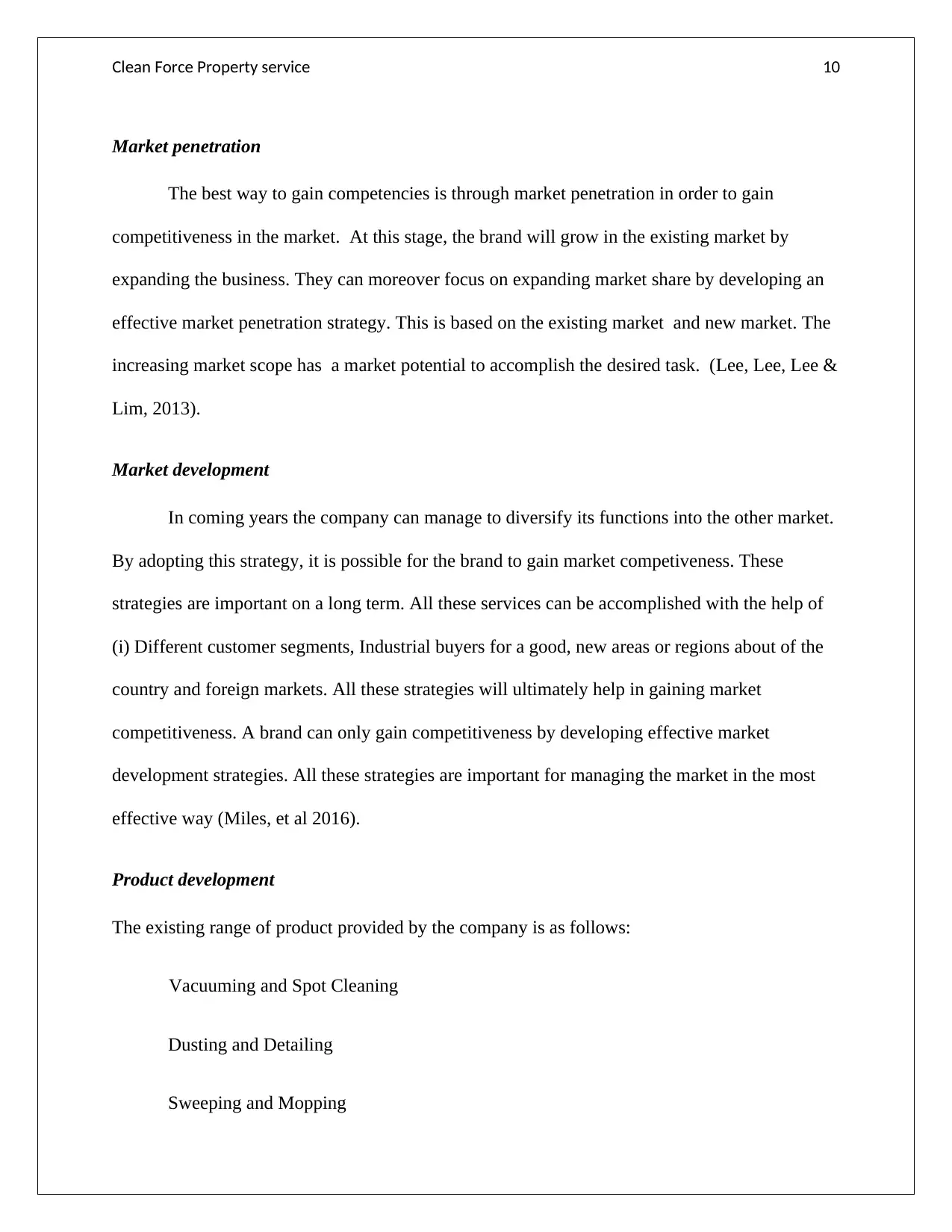
Clean Force Property service 10
Market penetration
The best way to gain competencies is through market penetration in order to gain
competitiveness in the market. At this stage, the brand will grow in the existing market by
expanding the business. They can moreover focus on expanding market share by developing an
effective market penetration strategy. This is based on the existing market and new market. The
increasing market scope has a market potential to accomplish the desired task. (Lee, Lee, Lee &
Lim, 2013).
Market development
In coming years the company can manage to diversify its functions into the other market.
By adopting this strategy, it is possible for the brand to gain market competiveness. These
strategies are important on a long term. All these services can be accomplished with the help of
(i) Different customer segments, Industrial buyers for a good, new areas or regions about of the
country and foreign markets. All these strategies will ultimately help in gaining market
competitiveness. A brand can only gain competitiveness by developing effective market
development strategies. All these strategies are important for managing the market in the most
effective way (Miles, et al 2016).
Product development
The existing range of product provided by the company is as follows:
Vacuuming and Spot Cleaning
Dusting and Detailing
Sweeping and Mopping
Market penetration
The best way to gain competencies is through market penetration in order to gain
competitiveness in the market. At this stage, the brand will grow in the existing market by
expanding the business. They can moreover focus on expanding market share by developing an
effective market penetration strategy. This is based on the existing market and new market. The
increasing market scope has a market potential to accomplish the desired task. (Lee, Lee, Lee &
Lim, 2013).
Market development
In coming years the company can manage to diversify its functions into the other market.
By adopting this strategy, it is possible for the brand to gain market competiveness. These
strategies are important on a long term. All these services can be accomplished with the help of
(i) Different customer segments, Industrial buyers for a good, new areas or regions about of the
country and foreign markets. All these strategies will ultimately help in gaining market
competitiveness. A brand can only gain competitiveness by developing effective market
development strategies. All these strategies are important for managing the market in the most
effective way (Miles, et al 2016).
Product development
The existing range of product provided by the company is as follows:
Vacuuming and Spot Cleaning
Dusting and Detailing
Sweeping and Mopping
Paraphrase This Document
Need a fresh take? Get an instant paraphrase of this document with our AI Paraphraser
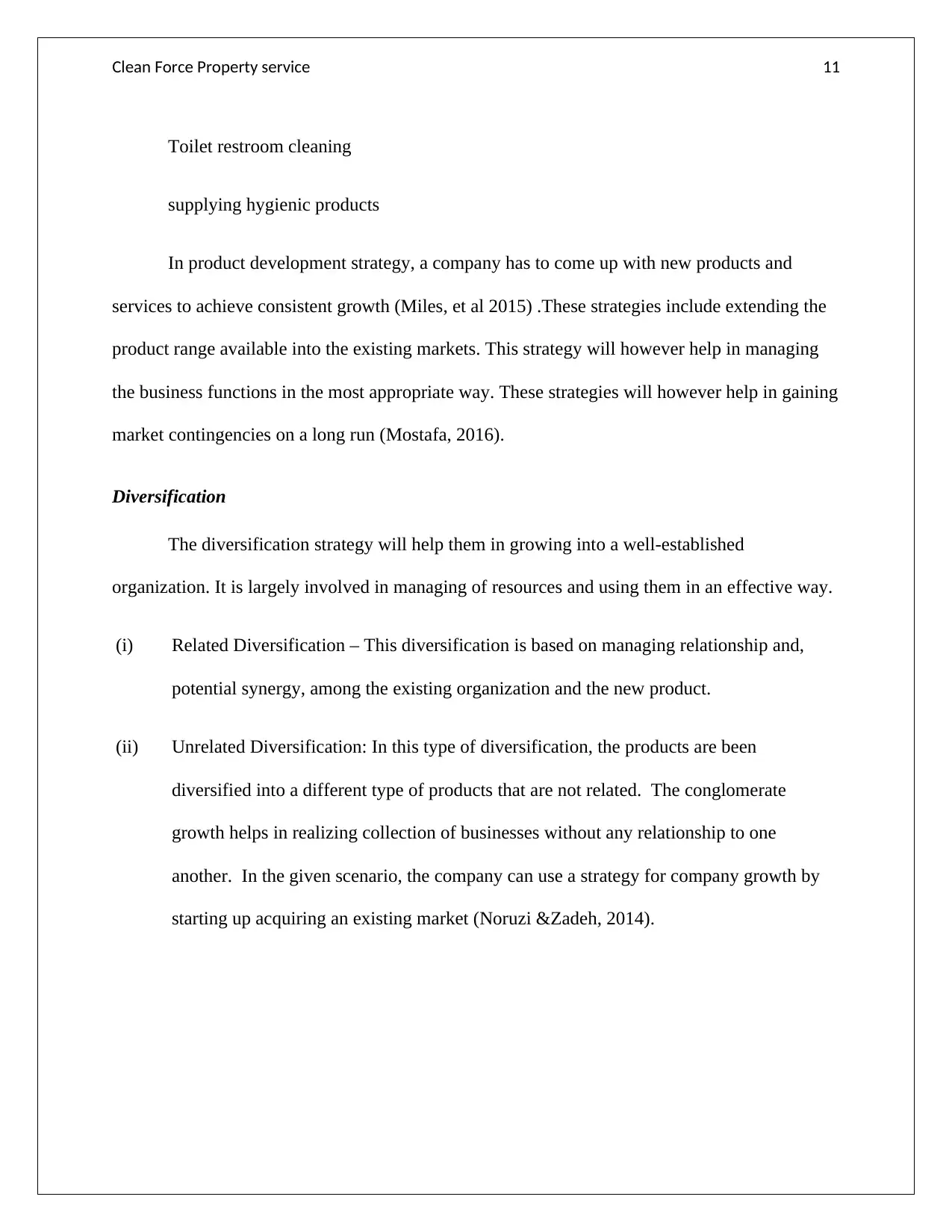
Clean Force Property service 11
Toilet restroom cleaning
supplying hygienic products
In product development strategy, a company has to come up with new products and
services to achieve consistent growth (Miles, et al 2015) .These strategies include extending the
product range available into the existing markets. This strategy will however help in managing
the business functions in the most appropriate way. These strategies will however help in gaining
market contingencies on a long run (Mostafa, 2016).
Diversification
The diversification strategy will help them in growing into a well-established
organization. It is largely involved in managing of resources and using them in an effective way.
(i) Related Diversification – This diversification is based on managing relationship and,
potential synergy, among the existing organization and the new product.
(ii) Unrelated Diversification: In this type of diversification, the products are been
diversified into a different type of products that are not related. The conglomerate
growth helps in realizing collection of businesses without any relationship to one
another. In the given scenario, the company can use a strategy for company growth by
starting up acquiring an existing market (Noruzi &Zadeh, 2014).
Toilet restroom cleaning
supplying hygienic products
In product development strategy, a company has to come up with new products and
services to achieve consistent growth (Miles, et al 2015) .These strategies include extending the
product range available into the existing markets. This strategy will however help in managing
the business functions in the most appropriate way. These strategies will however help in gaining
market contingencies on a long run (Mostafa, 2016).
Diversification
The diversification strategy will help them in growing into a well-established
organization. It is largely involved in managing of resources and using them in an effective way.
(i) Related Diversification – This diversification is based on managing relationship and,
potential synergy, among the existing organization and the new product.
(ii) Unrelated Diversification: In this type of diversification, the products are been
diversified into a different type of products that are not related. The conglomerate
growth helps in realizing collection of businesses without any relationship to one
another. In the given scenario, the company can use a strategy for company growth by
starting up acquiring an existing market (Noruzi &Zadeh, 2014).
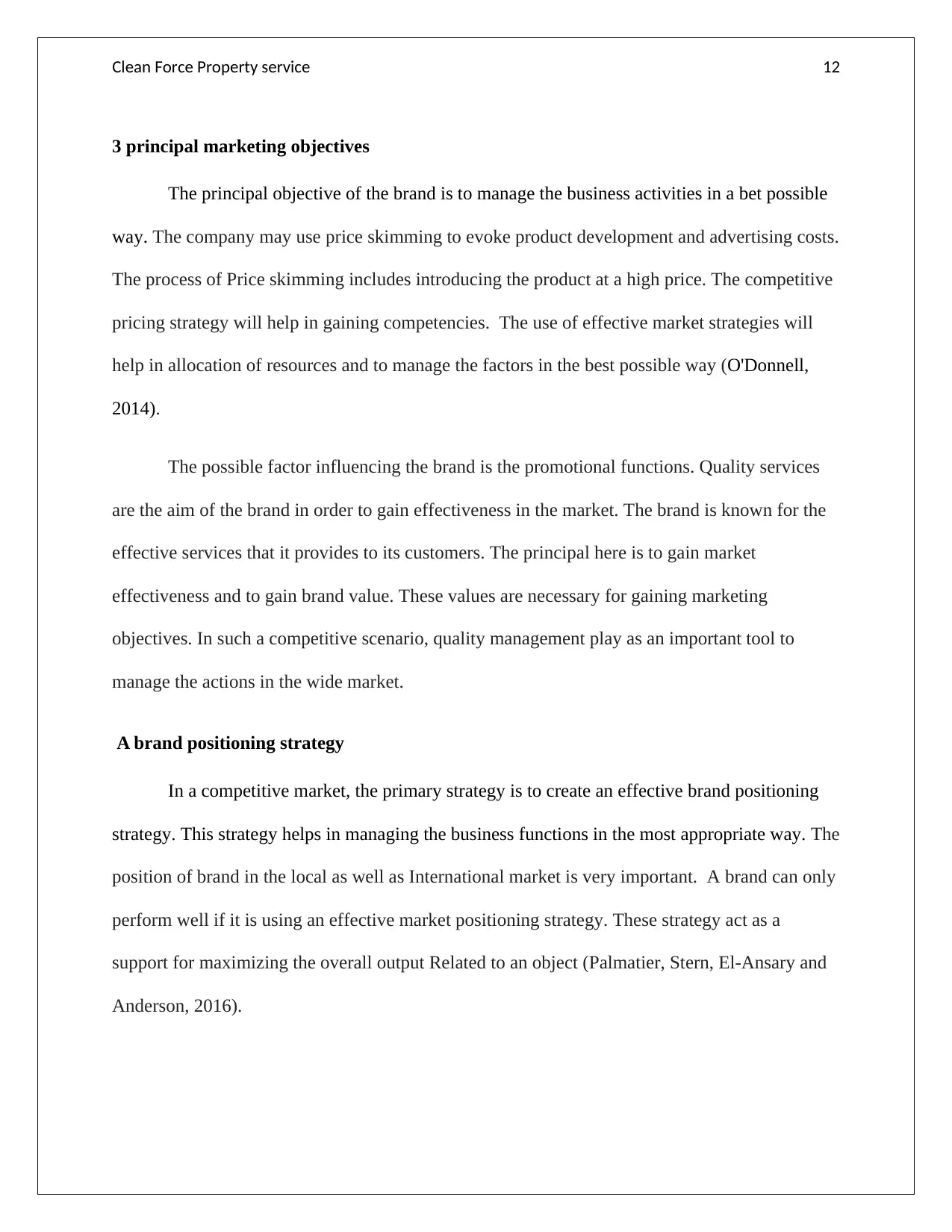
Clean Force Property service 12
3 principal marketing objectives
The principal objective of the brand is to manage the business activities in a bet possible
way. The company may use price skimming to evoke product development and advertising costs.
The process of Price skimming includes introducing the product at a high price. The competitive
pricing strategy will help in gaining competencies. The use of effective market strategies will
help in allocation of resources and to manage the factors in the best possible way (O'Donnell,
2014).
The possible factor influencing the brand is the promotional functions. Quality services
are the aim of the brand in order to gain effectiveness in the market. The brand is known for the
effective services that it provides to its customers. The principal here is to gain market
effectiveness and to gain brand value. These values are necessary for gaining marketing
objectives. In such a competitive scenario, quality management play as an important tool to
manage the actions in the wide market.
A brand positioning strategy
In a competitive market, the primary strategy is to create an effective brand positioning
strategy. This strategy helps in managing the business functions in the most appropriate way. The
position of brand in the local as well as International market is very important. A brand can only
perform well if it is using an effective market positioning strategy. These strategy act as a
support for maximizing the overall output Related to an object (Palmatier, Stern, El-Ansary and
Anderson, 2016).
3 principal marketing objectives
The principal objective of the brand is to manage the business activities in a bet possible
way. The company may use price skimming to evoke product development and advertising costs.
The process of Price skimming includes introducing the product at a high price. The competitive
pricing strategy will help in gaining competencies. The use of effective market strategies will
help in allocation of resources and to manage the factors in the best possible way (O'Donnell,
2014).
The possible factor influencing the brand is the promotional functions. Quality services
are the aim of the brand in order to gain effectiveness in the market. The brand is known for the
effective services that it provides to its customers. The principal here is to gain market
effectiveness and to gain brand value. These values are necessary for gaining marketing
objectives. In such a competitive scenario, quality management play as an important tool to
manage the actions in the wide market.
A brand positioning strategy
In a competitive market, the primary strategy is to create an effective brand positioning
strategy. This strategy helps in managing the business functions in the most appropriate way. The
position of brand in the local as well as International market is very important. A brand can only
perform well if it is using an effective market positioning strategy. These strategy act as a
support for maximizing the overall output Related to an object (Palmatier, Stern, El-Ansary and
Anderson, 2016).
⊘ This is a preview!⊘
Do you want full access?
Subscribe today to unlock all pages.

Trusted by 1+ million students worldwide
1 out of 17
Related Documents
Your All-in-One AI-Powered Toolkit for Academic Success.
+13062052269
info@desklib.com
Available 24*7 on WhatsApp / Email
![[object Object]](/_next/static/media/star-bottom.7253800d.svg)
Unlock your academic potential
Copyright © 2020–2025 A2Z Services. All Rights Reserved. Developed and managed by ZUCOL.





